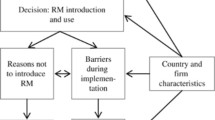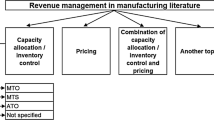Abstract
Previous research has extensively studied the application of revenue management (RM) in the service industry, but has given little attention to its application in the manufacturing industry. This article provides results of a quantitative study based on 479 firms of the process industry (PI) in North America and Europe. The results show that the overall importance of RM within the PI is regarded as high and that the importance is positively correlated with turnover, period of use and the extent of IT integration. The type of RM system used depends on its period of use: with increasing period of use, RM systems shift from capacity to price and capacity control. Barriers to the implementation of RM systems are seen in the absence of a clearly defined pricing strategy, lack of experience and lack of adequate approaches. Comparisons between North America and Europe indicate differences in the application of RM: In North America, RM is considered as more important, has been introduced earlier and is more price based.











Similar content being viewed by others
References
Barut, M. and Sridharan, V. (2005) Revenue management in order-driven production systems. Decision Sciences 36 (2): 287–316.
Beckmann, D., Menkhoff, L. and Suto, M. (2008) Does culture influence asset managers’ views and behavior? Journal of Economic Behavior & Organization 67 (1): 624–643.
Belobaba, P.P. (1989) Application of a probabilistic decision model to airline seat inventory control. Operations Research 37 (2): 183–197.
Blumenthal, P., Petersen, I. and Schubert, T. (2008) Application of Revenue Management to the Manufacturing Industry. Technical Report. Braunschweig University of Technology.
Charnsirisakskul, K., Griffin, P.M. and Keskinocak, P. (2006) Pricing and scheduling decisions with leadtime flexibility. European Journal of Operational Research 171 (1): 153–169.
Defregger, F. and Kuhn, H. (2007) Revenue management for a make-to-order company with limited inventory capacity. OR Spectrum 29 (1): 137–156.
Destatis – Federal Statitics Office Germany. (2010) Volkswirtschaftliche Gesamtrechnungen – Inlandsproduktberechnung Stand Februar 2010. Wiesbaden: Fachserie 18, Reihe 1.4.
Dun & Bradstreet Sales & Marketing database. (2005) http://www.dnb.com/sales-marketing/14881774-1.html.
Harris, F.H. and Pinder, J.P. (1995) A revenue management approach to demand management and order booking in assemble-to-order manufacturing. Journal of Operations Management 13 (4): 299–309.
IIE. (2011) http://www.iienet.org/Landing.aspx?id=887, Webpage of the Institute of Industrial Engineers.
Klophaus, R. and Pölt, S. (2007) Airline overbooking with dynamic spoilage costs. Journal of Revenue and Pricing Management 6 (1): 9–18.
Kolisch, R. and Zatta, D. (2009) Stand und Perspektiven des Einsatzes von Revenue Management in der Prozessindustrie. Zeitschrift für Planung & Unternehmenssteuerung 20 (2): 197–214.
Kuhn, H. and Defregger, F. (2005) Revenue Management in der Sachleistungswirtschaft: Eine empirische Untersuchung am Beispiel der Papier-, Stahl- und Aluminiumindustrie. Ingolstadt, DE: Katholische Universität Eichstätt-Ingolstadt. Research Report no. 171.
Littlewood, K. (1972) Forecasting and control of passenger bookings, Proceedings of the 12th AGIFORS Symposium, Nathanya, Israel, pp. 95–117.
Martin, G.S., Resick, C.S., Keatingand, M.A. and Dicksonn, M.W. (2009) Ethical leadership across cultures: A comparative analysis of German and US perspectives. Business Ethics 18 (2): 127–144.
Phillips, R.L. (2005) Pricing and Revenue Optimization. Stanford, CA: Stanford Business Books.
Quante, R., Meyr, H. and Fleischmann, M. (2009) Revenue management and demand fulfillment: Matching applications, models, and software. OR Spectrum 31 (1): 31–62.
Rindfleisch, A., Malter, A.J., Ganesan, S. and Moorman, C. (2008) Cross-sectional versus longitudinal survey research. Journal of Marketing Research 45 (3): 261–279.
Rothstein, M. (1971) An airline overbooking model. Transportation Science 5 (2): 180–192.
Spengler, T., Rehkopf, S. and Volling, T. (2007) Revenue management in make-to-order manufacturing – An application to the iron and steel industry. OR Spectrum 29 (1): 157–171.
Smith, B.C., Leimkuhler, J.F. and Darrow, R.M. (1992) Yield management at American airlines. Interfaces 22 (1): 8–31.
Talluri, K.T. and van Ryzin, G.J. (2004) The Theory and Practice of Revenue Management. Dordrecht, MA: Kluwer Academic Publishers.
Voigt, K.I., Saatmann, M. and Schorr, S. (2008) Flexibility and revenue management in the automotive industry. Journal of Enterprise Information Management 21 (4): 424–439.
Wallace, T.F. (1984) APICS Dictionary, 5th edn. American Production and Inventory Control Society.
Watanapa, B. and Techanitasawad, A. (2005a) Simultaneous price and due date settings for multiple customer classes. European Journal of Operational Research 166 (2): 351–368.
Watanapa, B. and Techanitasawad, A. (2005b) A genetic algorithm for the multi-class contingent bidding model. OR Spectrum 27 (4): 525–549.
Weatherford, L.R. (2009) Survey results from airlines that use revenue management software systems. Journal of Revenue and Pricing Management 8 (4): 323–329.
Weatherford, L.R. and Bodily, S.E. (1992) A taxonomy and research overview of perishable-asset revenue management: Yield management, overbooking, and pricing. Operations Research 40 (5): 831–844.
Weber, E.U. and Hsee, C. (1998) Cross-cultural differences in risk perception, but cross-cultural similarities in attitudes towards perceived risk. Management Science 44 (9): 1205–1217.
Wolfe, E.W. (2003) Using logistic regression to detect item-level non-response bias in surveys. Journal of Applied Measurement 4 (3): 234–248.
Author information
Authors and Affiliations
Corresponding author
Appendix
Rights and permissions
About this article
Cite this article
Kolisch, R., Zatta, D. Implementation of revenue management in the process industry of North America and Europe. J Revenue Pricing Manag 11, 191–209 (2012). https://doi.org/10.1057/rpm.2011.9
Received:
Revised:
Published:
Issue Date:
DOI: https://doi.org/10.1057/rpm.2011.9





